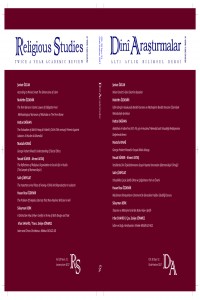Abstract
Hilya (Hilye-i
Şerîfe) denote sheets (levha), where The Prophet Muhammed (sav) is described in
writing. Many threnodies, qasides, poetry, mawlid and hilya were written in
order to praise beloved Prophet Muhammed (sav) and to present his humanistic
and moral properties throughout history. These texts, devoted to Prophet
Muhammed (sav), were written in the finest calligraphy of all: “Hüsn-i Hat”.
The first
examples of Hilya sheets were most probably written during Ottoman period. The
classical design, known today, was first seen in Calligrapher Hâfız Osman’s
work of art. The phases undergone until the ultimate form of design, are not
yet studied thoroughly. The Hilya, which is claimed to be the first, is
indecisive in terms of dating process.
Owing to the love
of The Prophet Muhammed (sav), Ottoman calligraphers wrote Hilya sheets with a
passion of divine service. As a result of this love, many different and unique
designs were devised and written.
Varieties in the
text are observed depending on different designs. Basmala, Hilya text, an Ayah
related to the Prophet Muhammed (sav) and names of the four caliphs of Islam
are available in the classical design of Hilya sheets.
The printed
“Hilye-i Şerîfe”, examined in this study, includes fifty two selected couplets
written in Ta’lik letters, from “Hilye-i Hâkânî”, apart from the classical
text. “Hilye-i Hâkânî” was written by Hâkânî Mehmed Efendi and it exceeds 710
couplets originally. Consequently, a distinctive “Hilye-i Şerîfe” in terms of
both design and text comes into the picture.
In this study, the differences in the text with
respect to the Hilye-i Hâkânî are discussed in the footnotes, besides from the
characteristics of the “Hilye-i Şerîfe”.
Keywords
Hilya (Hilye-i Şerîfe) Hilye-i Hâkânî the Prophet Muhammed (sav) Calligrapher Hâfız Osman Calligrapher I. Derviş Ali Hâkânî Mehmed Bey
References
- • ATALAY, Mehmet (1991a). “Hâkânî ve Hilye’si (I)”, Fırat Üniversitesi Dergisi Sosyal Bilimler, 5/I: 29-49.
- • ATALAY, Mehmet (1991). “Hâkânî ve Hilye’si (II)”, Fırat Üniversitesi Dergisi Sosyal Bilimler, 5/II: 33-58.
- • BERK, Süleyman (2001). “Bir Hilye-i Hakâni”, AD Art Dekor, S. 97: 94- 95.
- • BERK, Süleyman (2003). Hattat Mustafa Râkım Efendi, İstanbul, Kaynak Yayınları.
- • Çığ, Kemal (1949). Hattat Hâfız Osman Efendi, İstanbul, Uzman Laboratuvarı.
- • ERDOĞAN, Mehtap (2013). Türk Edebiyatında Manzum Hilyeler. İstanbul, Kitabevi.
- • HÂKÂNÎ, Mehmed b. Abdülcelîl (1292). Hilye-i Hâkânî. İstanbul, İmâmecizâde Mehmed Emin Bey Matbaası.
- • HÂKÂNÎ, Mehmed b. Abdülcelîl (1848/1264). Hilye-i Hâkânî, İstanbul, Matbaa-i Âmire.
- • HÂKÂNÎ, Mehmed b. Abdülcelîl (1307). Hilye-i Hâkânî, İstanbul, Mahmud Bey Matbaası.
- • HÂKÂNÎ, Mehmed b. Abdülcelîl (1317). Hilye-i Hâkânî, İstanbul, Şirket-i Sahafiye-i Osmâniye Matbaası.
- • KARAHAN, Abdülkadir (1992). Hakani Mehmed Bey’in Hilye-i Şerife’si. İstanbul, Sabah Gazetesi Yayını.
- • KARAMAN, Hayreddin (2008). Hilye, İstanbul, Ufuk Kitapları.
- • PALA, İskender (1991). Hilye-i Saadet. Ankara, Türkiye Diyanet Vakfı.
- • PALA, İskender (1997). “Hilye-i Saadet’in Caizesi”, Türk Edebiyatı, S. 279: 78- 81.
- • UZUN, Mustafa (1997). “Hâkânî Mehmed Bey”, Türkiye Diyanet Vakfı İslâm Ansiklopedisi, İstanbul, Türkiye Diyanet Vakfı, c. XV: 166- 168.
- • UZUN, Mustafa (1998). “Hilye”, Türkiye Diyanet Vakfı İslâm Ansiklopedisi, İstanbul, Türkiye Diyanet Vakfı, c. XVIII: 44- 47.
- • YARDIM, Ali (1997). Peygamberimizin Şemâili. İstanbul, Damla Yayınları.
Abstract
Hilye-i Şerîfe, Hz. Peygamber (sav)’in yazı ile anlatıldığı
levhalardır. Tarih boyunca Hz. Peygamber’i övmek, insânî ve ahlâkî vasıflarını
ortaya koymak için pek çok metin
ortaya konulmuştur.
Bugün bilinen klâsik anlamdaki levha Hilye tasarımı ilk defa
Hattat Hâfız Osman’da görülmüştür. Fakat Hilye-i Şerîfe levhasının bu tasarımı
alana kadar geçirdiği safhalar henüz tam olarak ortaya konulmuş değildir.
Hilye-i Şerîfe’lerin farklı tasarımlarına bağlı olarak, ana
hilye metni dışında farklılıklara da rastlanmaktadır. Klâsik Hilye-i Şerîfe
levhalarında Besmele, Hilye metni, Hz. Peygamber (sav) ile ilgili bir Âyet-i
kerîme ile dört halîfenin isimleri bulunmaktadır. Bu klâsik tertibin dışında
çok farklı metinlerle Hilye-i Şerîfe levhalarını görmekteyiz.
Makale konusu ettiğimiz baskı Hilye-i
Şerife’de de klâsik hilye metni dışında Hâkânî Mehmed Efendi tarafından kaleme
alınan ve aslı 710 beyti aşan Hilye-i Hâkânî’den elli iki seçme beyit Ta’lik
hurûfât ile dizilmiştir. Böylece ortaya tasarımı ve metni ile farklı bir
Hilye-i Şerîfe çıkmıştır. Bu Hilye-i Şerîfe levhası’nda da dört halîfenin
isimleri ve Hz. Peygamber (sav) ilgili âyet (Enbiyâ Suresi 107) bulunmaktadır.
Keywords
Hilye-i Şerîfe Hilye-i Hâkânî Hz. Peygamber (sav) Hattat Hâfız Osman Hattat I. Derviş Ali Hâkânî Mehmed Bey
References
- • ATALAY, Mehmet (1991a). “Hâkânî ve Hilye’si (I)”, Fırat Üniversitesi Dergisi Sosyal Bilimler, 5/I: 29-49.
- • ATALAY, Mehmet (1991). “Hâkânî ve Hilye’si (II)”, Fırat Üniversitesi Dergisi Sosyal Bilimler, 5/II: 33-58.
- • BERK, Süleyman (2001). “Bir Hilye-i Hakâni”, AD Art Dekor, S. 97: 94- 95.
- • BERK, Süleyman (2003). Hattat Mustafa Râkım Efendi, İstanbul, Kaynak Yayınları.
- • Çığ, Kemal (1949). Hattat Hâfız Osman Efendi, İstanbul, Uzman Laboratuvarı.
- • ERDOĞAN, Mehtap (2013). Türk Edebiyatında Manzum Hilyeler. İstanbul, Kitabevi.
- • HÂKÂNÎ, Mehmed b. Abdülcelîl (1292). Hilye-i Hâkânî. İstanbul, İmâmecizâde Mehmed Emin Bey Matbaası.
- • HÂKÂNÎ, Mehmed b. Abdülcelîl (1848/1264). Hilye-i Hâkânî, İstanbul, Matbaa-i Âmire.
- • HÂKÂNÎ, Mehmed b. Abdülcelîl (1307). Hilye-i Hâkânî, İstanbul, Mahmud Bey Matbaası.
- • HÂKÂNÎ, Mehmed b. Abdülcelîl (1317). Hilye-i Hâkânî, İstanbul, Şirket-i Sahafiye-i Osmâniye Matbaası.
- • KARAHAN, Abdülkadir (1992). Hakani Mehmed Bey’in Hilye-i Şerife’si. İstanbul, Sabah Gazetesi Yayını.
- • KARAMAN, Hayreddin (2008). Hilye, İstanbul, Ufuk Kitapları.
- • PALA, İskender (1991). Hilye-i Saadet. Ankara, Türkiye Diyanet Vakfı.
- • PALA, İskender (1997). “Hilye-i Saadet’in Caizesi”, Türk Edebiyatı, S. 279: 78- 81.
- • UZUN, Mustafa (1997). “Hâkânî Mehmed Bey”, Türkiye Diyanet Vakfı İslâm Ansiklopedisi, İstanbul, Türkiye Diyanet Vakfı, c. XV: 166- 168.
- • UZUN, Mustafa (1998). “Hilye”, Türkiye Diyanet Vakfı İslâm Ansiklopedisi, İstanbul, Türkiye Diyanet Vakfı, c. XVIII: 44- 47.
- • YARDIM, Ali (1997). Peygamberimizin Şemâili. İstanbul, Damla Yayınları.
Details
| Journal Section | Articles |
|---|---|
| Authors | |
| Publication Date | June 19, 2017 |
| Published in Issue | Year 2017 Volume: 20 Issue: 51 (19-06-2017) |

